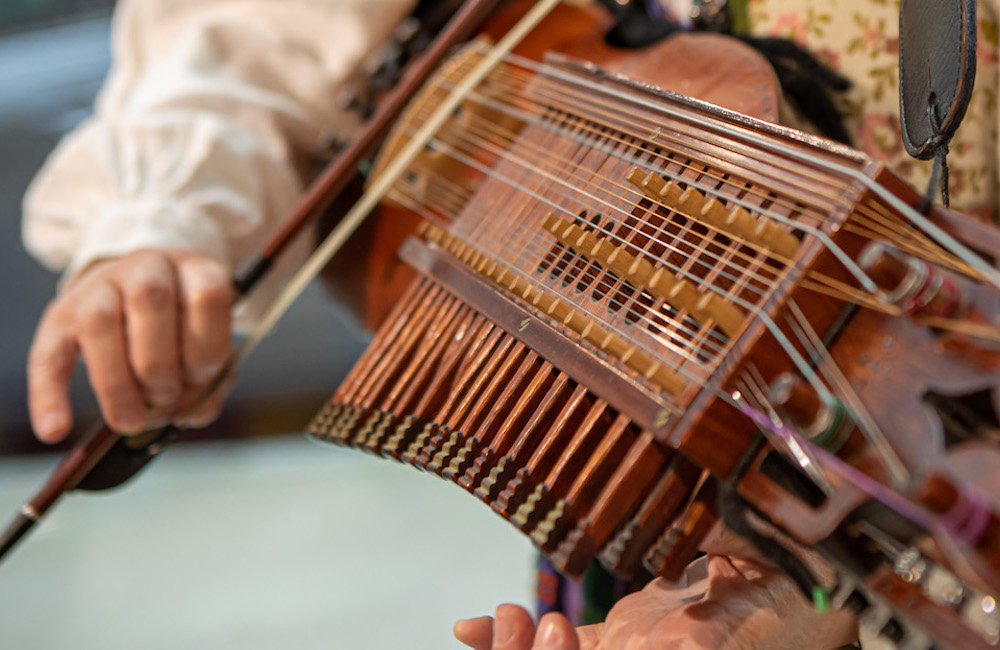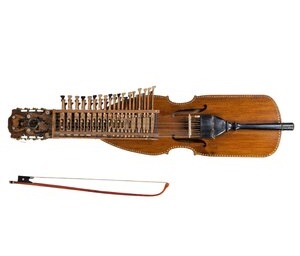Nyckelharpa
Bowed Instruments
Europe
Between 1001 and 1900 AD
Video
The Nyckelharpa, a traditional Swedish musical instrument, is a remarkable blend of history, craftsmanship, and cultural significance. Known for its unique sound and intricate design, the Nyckelharpa has captivated musicians and audiences alike for centuries.
The Nyckelharpa is a stringed instrument that combines elements of both the fiddle and the harp. It typically features a body similar to that of a small violin with a distinctive set of keys that allow the player to change the pitch of the strings. The instrument is played with a bow, and it has a rich tonal quality that resonates beautifully. The name “Nyckelharpa” translates to “key harp,” where “nyckel” means key and “harpa” refers to harp or stringed instrument. The modern chromatic version of the Nyckelharpa usually has 16 strings: three melody strings, one drone string, and twelve sympathetic strings that vibrate in resonance with the melody strings. The keys on the instrument slide under the strings and have tangents that stop the string at specific points to create different notes. This unique design allows for a wide range of musical expressions.
History of the Nyckelharpa
Origins and Development
The origins of the Nyckelharpa can be traced back to medieval Europe, specifically Sweden. The earliest known depiction of an instrument resembling the Nyckelharpa dates back to around 1350 AD in a stone carving found in Källunge Church on Gotland, Sweden. This carving suggests that similar instruments were present in Sweden during this period. Additionally, frescoes from Italy dating back to 1408 also depict instruments that resemble the Nyckelharpa. Throughout the centuries, various forms of the Nyckelharpa evolved. By the 17th century, it had developed into more recognizable forms seen today. The first well-documented type is known as “kontrabasharpa,” which emerged in the Uppsala region between 1630 and 1640. Historical records indicate that by this time, the Nyckelharpa was already integrated into Swedish folk music traditions. During the Baroque period, references to key-fiddles like the Nyckelharpa became more common in musical treatises by composers such as Michael Praetorius. However, after this period, evidence of its use became increasingly concentrated in Sweden, particularly in Uppland province, where a continuous tradition of playing persisted.
Revival and Modern Usage
Despite its rich history, the Nyckelharpa faced challenges during the 20th century. By the mid-1900s, interest in traditional folk instruments waned significantly, leading to a decline in its popularity. However, a revival began in the late 1950s when Swedish authorities recognized the need to preserve this cultural heritage. The government initiated efforts to promote folk music education and instrument making. One significant figure in this revival was Eric Sahlström, who redesigned and popularized a modern three-rowed chromatic version of the Nyckelharpa in 1929. His work laid the foundation for contemporary players and helped re-establish interest in this unique instrument. Today, there are approximately 10,000 active Nyckelharpa players in Sweden alone.
How It Works
The Nyckelharpa operates through a combination of bowing and key-pressing techniques. The player uses their right hand to draw a bow across the melody strings while simultaneously pressing down on keys with their left hand. Each key corresponds to a specific note by stopping one or more strings at designated points along their length.
String Configuration
Melody Strings: The primary strings used for playing melodies.
Drone String: A single string that provides a continuous pitch background.
Sympathetic Strings: These additional strings resonate with the melody strings when played, enriching the overall sound.
The interaction between these components allows for complex harmonies and textures within performances. The sympathetic strings add depth to the sound without requiring additional effort from the player.
Types of Nyckelharpas
There are several types of Nyckelharpas that have evolved over time:
- Gammelharpa: An older form featuring fewer keys (often one or two) and typically used for traditional folk music.
- Kontrabasharpa: A larger variant designed for lower pitches.
- Silverbasharpa: A version with specific tuning capabilities.
- Modern Chromatic Nyckelharpa: Features three or four rows of keys allowing for greater chromatic playability and resonance.
Each type has its unique characteristics suited for different styles of music.
Features
The Nyckelharpa boasts several distinctive features:
Keys: Arranged along the neck; each key has a tangent that stops a string at specific points.
Strings: The combination of melody strings, drone string, and sympathetic strings creates a rich sound palette.
Range: Modern versions typically have a range spanning three octaves.
Construction: Traditionally made from wood with intricate craftsmanship reflecting Swedish folk art.
These features contribute not only to its sound but also to its visual appeal as an instrument deeply rooted in cultural identity.
Kind of Music Composed
The music composed for the Nyckelharpa primarily falls within Swedish folk traditions. It is commonly associated with various dance forms such as polskas and waltzes. The instrument’s ability to produce both melody and drone harmonies makes it versatile for solo performances as well as ensemble settings.In recent years, musicians have begun incorporating the Nyckelharpa into diverse genres beyond traditional folk music. Its unique sound has found its place in contemporary classical compositions as well as experimental music genres. This versatility showcases how traditional instruments can adapt and thrive within modern musical landscapes.
Significance
The significance of the Nyckelharpa extends beyond its musical capabilities; it represents an essential aspect of Swedish cultural heritage. As an object of historical research and an aesthetic artifact displayed in museums across Sweden, it serves as a reminder of Sweden’s vibrant folk music history. Moreover, efforts to revive interest in traditional instruments like the Nyckelharpa have led to increased participation in folk music communities throughout Sweden. Festivals celebrating folk traditions often feature performances with this instrument, highlighting its role in preserving cultural identity. Additionally, contemporary musicians are increasingly drawn to the Nyckelharpa’s unique sound and expressive potential. This interest not only keeps the instrument relevant but also introduces it to new audiences worldwide.
It is more than just an instrument; it embodies centuries of history and cultural significance within Sweden. Its distinctive sound continues to inspire musicians today while serving as a vital link between traditions and contemporary expressions.
FAQ
What is the Nyckelharpa made of?
The Nyckelharpa is traditionally crafted from spruce or maple for the body, with keys made from hardwood. The strings are typically steel, while the instrument often features decorative inlays and a resin-treated soundboard for resonance.
What is the Nyckelharpa used for?
The Nyckelharpa is used primarily in Swedish folk music but also appears in modern and classical compositions. It produces a melodic and resonant sound ideal for traditional dances and folk ensembles.
What is the origin of the Nyckelharpa?
The Nyckelharpa originated in Sweden, with the earliest depictions dating back to the 14th century. It evolved as a key instrument in Swedish folk music, particularly in the Uppland region.
 Links
Links
References
Other Instrument
Categories



















